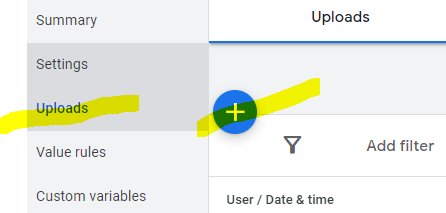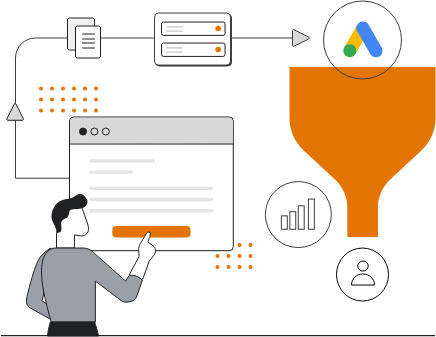What Are Offline Conversions
And Why Are They Vital For Google Ads Optimization?
I. Introduction
Do you want to increase revenue and improve lead quality?
In this blog, we will tell you exactly how to do both with a critical yet often overlooked tool in your arsenal: offline conversions. By the end of this blog, you'll be able to unlock the potential of this powerful marketing strategy.
Do you want to increase revenue and improve lead quality?
In this blog, we will tell you exactly how to do both with a critical yet often overlooked tool in your arsenal: offline conversions. By the end of this blog, you'll be able to unlock the potential of this powerful marketing strategy.
II. Demystifying Offline Conversions: For Lead Quality & E-commerce
The first step is understanding offline conversions. Let's break down this term. "Offline" refers to customer actions that occur outside of an online setting, including phone calls and in-store purchases.
Offline conversions link your online marketing efforts with offline outcomes, providing a full picture of the customer journey. This is essential for businesses invested in marketing best practices, such as optimizing Google advertising or launching targeted campaigns. In order to do this well, these businesses must track the whole sales funnel, from the initial click all the way to a phone call or in-store visit (i.e. an offline conversion). Offline conversions make this process more efficient.
Lastly, offline conversions allow lead generation businesses to accurately track the level of interest and quality of the leads that they generate. Only by tracking offline conversions and uploading these conversions to their ad platforms will lead-generation businesses that are actively combating spam be successful. This is because their platforms will be able to optimize by providing a more accurate reflection of the quality of leads. You will know your spend is accurately generating high-quality leads, not spam or leads that will not convert.
III. Offline Conversions: An Unseen Asset in E-commerce and Lead Gen Businesses
Offline conversions are critical to e-commerce and lead-generation businesses because online views are just one part of the sales funnel. Offline conversions are needed to complete the picture of the customer journey and enable the optimization of online customer touchpoints.
Offline conversions are critical to e-commerce and lead-generation businesses because online views are just one part of the sales funnel. Offline conversions are needed to complete the picture of the customer journey and enable the optimization of online customer touchpoints.
Most marketers struggle to understand the efficiency of their online advertising dollars. An ad has a click, but what is the outcome of that click? A purchase? An inquiry?
When we look back on online advertising as a whole, we ask: How many people bought a product or filled out a form as a result of your advertising? We don’t have a clear picture of that - even though ad platforms claim to offer it.
Online platforms like Facebook temporarily keep track of what happens to users after a click to provide a general look at online conversion rates. Their reports lack accuracy and detail, though, and they disappear after around two months, making precise analysis impossible.
As such, businesses miss value opportunities by making investments in one area while scaling back efforts in another that could have been the driving force behind campaign success. Offline conversions allow businesses to obtain the missing data, leading to smarter budgets and greater efficiency.
Example: Johnny is a small businessman who's looking to triple his sales. He invested tens of thousands of dollars to create his new website, and sales have blown up ever since...or so he thinks. While website visits are up, Johnny cannot be sure if those sales originally saw an ad and converted later or if those sales came from his social media influencer campaigns. His analytics report offers limited information on online conversion rates, and he's unsure if the variance is due to user behavior or inaccuracies in data collection. Finally, Johnny decides to adopt an offline conversion strategy to expand his understanding of the customer journey.
With an offline conversion strategy, Johnny discovers that around half of website visitors were starting their search in the store, browsing his offers, and looking for details before making a final purchase online. He can tell as well that while social media is driving website visits, customers only convert after looking at a Google ad and then being contacted by a sales rep. Johnny now has the full picture, and in turn, he can tailor his marketing spend to maximize returns and grow his business.
IV. Offline Conversions: The Secret Sauce to Enhancing Lead Quality

When discussing lead quality, we must consider the time and money invested in generating leads. Due to the high cost involved with acquiring leads, it is imperative for lead generation companies to provide the best quality and most qualified leads possible. Imagine investing thousands of dollars to get thousands of users into your app, but then realizing that a large proportion of those users are bot accounts or are simply not interested in the offer that they viewed.
Neither of these groups of users provides any value to a business, and they only increase the cost associated with acquiring users. Only offline conversions uniquely tie the lead generated to the activity that drove the user. If the lead isn't genuinely interested in what is being offered, then the advertiser won't see another successful conversion from that ad unit -- for so long as the ad unit is up and active.
Click-through rates cannot accurately reflect offsite user behavior because it conveys that the user clicked on an ad unit, but there is no evident follow-through. Many leads that are bots or unqualified leads may fill out a lead form, telling your ad platform that you are converting when in reality, your sales funnel is full of trash. Offline conversions are stronger indicators of lead quality because there is a direct linkage between the ad unit and the successful conversion/offline event.
Uploading this offline conversion data refines future advertising strategies, leading to improved business outcomes. Google can accurately track conversions, marking those unqualified conversions as pathways to avoid.
V. The How-To Guide on Uploading Offline Conversions
Now, let's navigate the process of uploading offline conversions.
This can be as simple as noting details when a customer refers to an online ad or as advanced as using unique promotional codes This data, once uploaded to your ad platform, becomes a valuable asset in your marketing strategy.
Use the instructions below to guide you through uploading offline conversions in Google:
The process of uploading offline conversions is straightforward. Assuming you are using an upload file that utilizes Google Click IDs captured by, for example, your CRM system, follow the below steps:
1. Prepare your upload file

a) Line 1 will consist of your time zone area parameter
b) Line 2 will be your data headers consisting of your:
• Google click ID
• A Transaction ID
• The conversion name that you set up under “Tools and Settings” → Measurement → Conversions
• The conversion date/time stamp
• The conversion value
• The currency code
c) Line 3 and beyond is where you input your actual data
2. Log in to your Google Adwords Account
3. Click on “Tools and settings” then “Conversions” in the top menu bar area

4. On the left-hand navigation area, click “Uploads”, then the blue + image

5. In the “Select Source” drop-down, choose “Upload A File” and choose the file you created above
6. Next, select Apply, Preview, or Cancel.
a) Selecting Preview will send the file through some initial QA checks so you can see if there will be any obvious issues with the file

7. You will then see your upload, and its status show up in the listings area. It can take several hours for your newly uploaded conversion listings to show up in your statistics.
Best Practices:
• Upload an extra day’s worth of data with each import
• Duplicates will not be counted, and you will receive an error message
• Offline conversions uploaded more than 90 days after the last click won’t be imported
• Imported conversion stats won’t show up in the Google Ads account for about 3 hours after the upload
Platforms like Google Ads and Facebook Ads Manager offer comprehensive resources to support you in this process, underlining the importance of offline conversions for businesses looking to optimize advertising.
VI. Offline Conversions: The Backbone of Data-Driven Strategies
In today's business world, data-driven marketing strategies are essential. Offline conversions enrich these strategies by providing a full view of your customer's journey from the first online touchpoint to the final offline conversion.
This understanding allows for more precise marketing efforts, leading to more successful and targeted campaigns. Specifically, by uploading this data to our ad platforms, we can more accurately retarget previous users to increase the likelihood of a successful conversion. This also allows for platforms to target users that will buy instead of targeting bots and spam.
Platforms need this information in order to truly see where and when the customer should be targeted. A problem regularly encountered by marketers is analysis paralysis. That is, you are getting pulled in all directions by a wide array of data and channels. Offline conversion strategies narrow the field of data to consider, allowing for more effective methodologies and strategies.
VII. Best Practices When Uploading Offline Conversions

When it comes to data, leveraging your resources is critical. While the rest of the strategy is important, lacking an efficient way to accurately report conversions (or offline conversions) to platforms, the whole strategy falls apart because the ad spend will never be effectively optimized.
If businesses develop a more efficient way to report offline conversions, they will find themselves better able to avoid challenges when implementing this strategy. This means investing more time when mapping out a strategy specifically into building out the technology to report accurate conversions back to their ad platforms.
The revenue gains that follow over the years are well worth it. This isn’t just a five-piece puzzle with a clear vision of what parts of the puzzle need to fall together. Businesses need to add a whole new dimension to the puzzle, one where they solve the puzzle separately and then they slot it in and see if they missed anything so that the puzzle is complete. Any puzzle pieced together with just one part of the strategy will collapse in the long run and have to be rebuilt.
A robust system for tracking offline conversions and regular uploading can help you avoid the above challenges, contributing to better business operations and improved revenue.
VIII. Conclusion and Call to Action
Our discussion has explained the potential of offline conversions, highlighting their importance in e-commerce and lead-gen businesses and their role in enhancing lead quality. We've provided practical advice on uploading offline conversions, explained their importance in data-driven marketing, and provided tips to avoid common mistakes.
Offline conversions offer a lot of information, leading to a better understanding of your customers, improved marketing strategies, and enhanced business performance. It's clear - offline conversions are a significant factor in the business success equation. Start the process of uploading your offline conversions and watch your Google Ads optimize faster.

